Hello, my name is Ian Snapp, and I will be interning at the Scripps Dorris Neuroscience Center (DNC) in La Jolla, California, for, as the name suggests, neuroscience. This internship will span from June 17th to July 26th (six weeks), and my work schedule will be 9:00 to 5:00 each day approximately. My mentors will be Leyao Shen and her undergrad technician, Dawn Hoffer, within the Ye lab. The focus of this group largely falls within the realms of molecular biology and biochemistry to study metabolism within the nervous system. I am still learning the full breadth of what exactly this entails, but it largely regards the manipulation and cloning of DNA along with corresponding proteins
Travel
Before I could start my internship, I first had to get from Ridgway, Colorado, all the way to San Diego, California, an endeavor I chose to partake in by car. Fortunately, I wasn’t alone because my dad had to drive with me in order to help sign me into the Air-Bnb I am going to be residing at. After the initial encounter is over, I will be allowed to live alone by Air-Bnb’s standards, but I am beyond grateful for the time and energy my dad was willing to commit to help get me settled in. However, we thankfully took this necessary trip as an opportunity to have a family vacation, so my sister got dragged along with us. They will be staying for a little over a week to explore San Diego with me until their flight back to Colorado, which is, again, an amazing thing they were willing to do.
My family and I decided to leave on Friday, the fourteenth, so that we could take our time on the road. So, once the day was coming to an end, we all set out from Ridgway to start our fourteen-hour drive. The three of us made our way through Colorado and a couple of hours into Arizona by around 4:00 in the morning, which is around when we tucked off the road and tried to get some zzz’s until the sun rose.
Three and some hours of much-needed sleep later, we hopped on the road again to continue our drive through Arizona. This drive included taking a detour to drive along the rim of the Grand Canyon. We ended up taking five or so hours to drive through the park because we were trying to explore as much as we could in the short amount of time we had. Following the canyon, we drove through Sedona, Arizona, briefly stopping to use the restrooms and walk around before we ultimately arrived in Phoenix to get a good night’s rest at a hotel before the final push for San Diego.
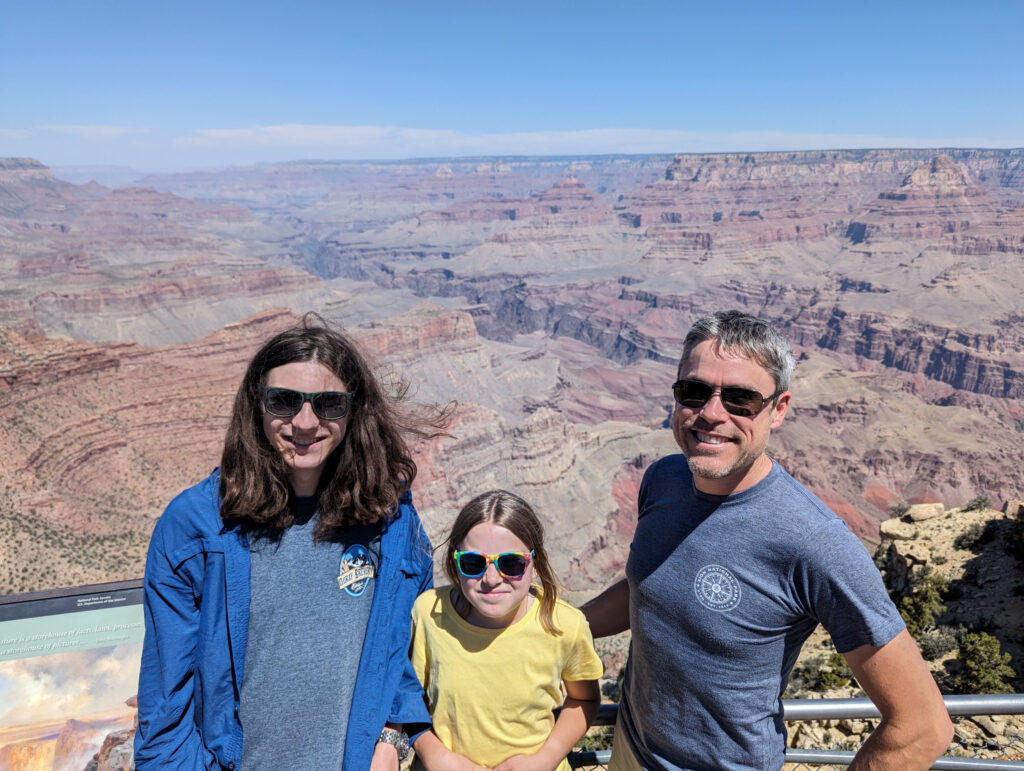
My family and I at the rim of the Grand Canyon.
The following morning, Sunday the sixteenth, we woke up, packed our things, and headed out. This final stretch of road went nearly due west along I-8. This specific road nearly touches the U.S.-Mexico border, which allowed my sister and I to view a little bit of Mexico for the first time. On top of that, we got to experience some of the thrill of driving through the desolate desert with temperatures reaching 110+ Fahrenheit, a surreal experience. After several more hours of the desert, we finally drove up into the Air-Bnb parking lot, where we checked in and got ready for the week. While this was a relaxed and comfortable drive, getting to settle down in my new home was a relief.
Work Week
Monday
Monday was by far the busiest day of the week for me. First off, I had to get my badge, car parking permit, and any other security clearances prepared via the Scripps administration building (s). Then, I had to drive over to the DNC as it is where my internship is taking place. Here, I met my mentors, took a tour of the lab, and went to our team’s group lunch.
Following lunch is when the lab work began, though this week was used more as a shadowing of all the procedures that I will soon be either doing or assisting. The reason for this is because I needed to read through more Scripps policies, sign some paperwork, do a safety course, and just because it was my mentor’s request that I try to learn what I can before I do hands-on work. For the rest of the day, I observed six main procedures used in the lab: PCR, DPN1 digestion, agar plate prep., gel electrophoresis, gel extraction, and Gibson cloning.
A PCR (polymerase chain reaction) essentially tears DNA apart (denatures) via heat into single-strand DNA (ssDNA) instead of the normal double-helix DNA people normally picture. This resulting ssDNA is reacted with what is called a primer, short segments of DNA, which bind to what is called the target segment of the ssDNA (essentially the part that is trying to be manipulated). The final step is using an enzyme to elongate the primer, which attaches to the ssDNA, creating a longer chain of double-strand DNA.
Once this is complete, a DPN1 digestion reaction was performed on the resulting product of the PCR. A digestion reaction is normally a reaction used to cut or destroy parts of DNA using an enzyme. In this case, it is used to remove the template DNA that was methylated (reacted to add a methyl molecule to the DNA). DNA is methylated naturally by the body to regulate the sequence of DNA by preventing additional building blocks from being added (nucleotides). This can also be done artificially to prevent more genetic code from being added, formed, etc. I, however, don’t know if it was intentional in this case. Anyways, the DPN1 digestion uses the DPN1 enzyme to remove all methylated DNA (the template) to avoid replicating it later during the cloning process which could skew the results.
I briefly watched as Dawn, the tech, prepared an agar mix. This essentially is a gelatinous, but nutritious substance that can be cast into plates to grow microorganisms. This is done by mixing pure water with agar mix, heating it in an autoclave to sterilize it, and casting the resulting mix into plates under a vent hood.
Next was the gel electrophoresis, which essentially means putting a dye in the DNA solutions, putting it into a gel mold, and inducing a current through it. The DNA is negatively charged and will move to the positive terminal. However, the speed at which it traverses to the terminal is dependent on its size, which can be used to sort DNA molecules/sequences. As far as I am aware, this was used to isolate the modified DNA, which was then extracted.
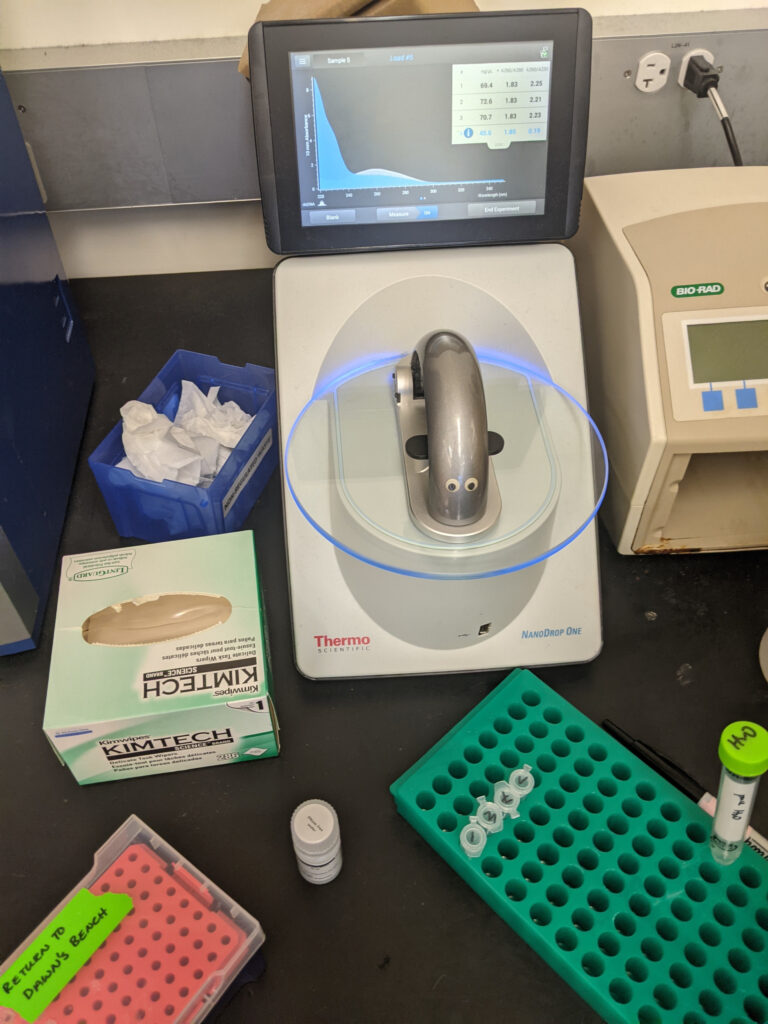
This is the machine used (called a Nanodrop) to test for the DNA concentrations after the gel electrophoresis.
The Gibson cloning process uses a patented mix of enzymes to attach small fragments of DNA into a larger strand, completing a plasmid. Once these plasmids are made (essentially a circle of DNA), they are put into a bacteria-rich environment so the bacteria absorb them. The bacteria will then copy the plasmids and replicate them along with its reproductive cycle. This, in turn, will create clones of the DNA/plasmid sequence en masse, which can be studied further.
Tuesday
On Tuesday, I toured the lab and learned some safety procedures with two other interns, Katie and Logan, as per Scripps protocol. Then, I got to witness the process used to make the liquid culture and TC water (water rated to be used in the handling of tissue cultures). To make TC water, deionized/molecular water is sterilized in an autoclave. The liquid culture is just a nutritious powder that is mixed into molecular water, which is then sterilized. This is then put into flasks and refrigerated until use.
After this, I watched the cell splitting procedure. This essentially was just expanding the cancerous, neuron-like cell colonies (originally from mice) used to clone DNA and proteins. Cancerous cells are used because their reproductive cycle is uninhibited, meaning they will reproduce without a resting period exponentially increasing in size unlike cancer-free neurons resulting in a cheap and effective way to produce more DNA and/or proteins. This is done by taking the original cell colonies, removing the solutions they are in, and moving the organisms to a new nutritious medium to grow on and expand (almost like replanting them in a bigger more nutritious pot).
Finally, I observed a variation of the Western Blot technique. This effectively is the gel electrophoresis procedure from earlier, but it is used to distinguish between different-sized proteins instead of DNA. However, it was mainly used to test and see if the proteins that were created by Leyao were the right size.
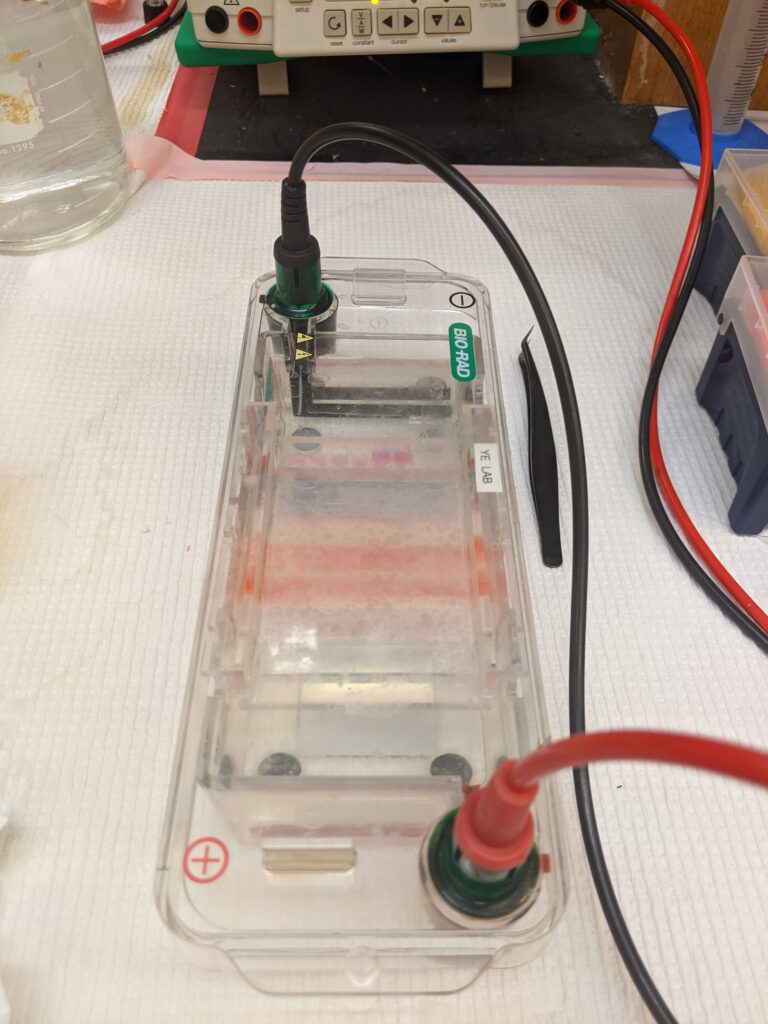
This is the gel electrophoresis reaction used in the Western Blot procedure.
Wednesday
This day was used to perform the miniprep technique. This is a process used to extract and isolate the DNA from the bacteria used in the cloning process. In order to study the DNA, it needs to be independent of most other things. This is done by dissolving the bacteria in a basic solution that is neutralized to be non-basic once the reaction is complete (to avoid destroying the bacteria). Once it is outside of the bacteria, it is centrifuged to put all the dense DNA towards the bottom. Finally, it is washed several times and filtered to remove all other contaminants. This produces a small amount of isolated DNA that can be stored long-term for a record.
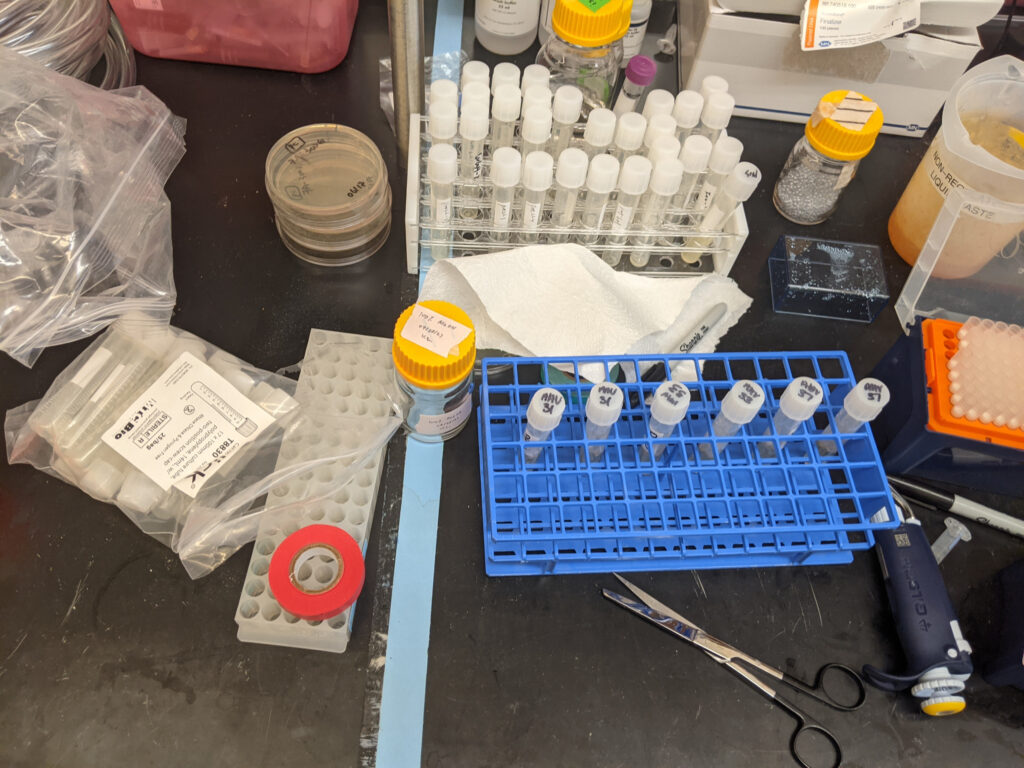
These are the tubes that contain the bacteria pellets (condensed bacteria colonies) used in the miniprep.
Thursday
Today we finished the Western Blot previously mentioned/started and performed a midiprep. This Western Blot resulted in the proteins getting separated by size, which was then chosen, extracted, and suspended into a fluid. Once this was done, we performed an analysis on the concentration of the protein by shining a bright light and analyzing the wavelengths absorbed. The proteins will absorb a specific wavelength of light which means the more that light is absorbed, the higher the concentration of protein is suspended in the solution. Furthermore, the previous miniprep was extrapolated into today’s midiprep. Essentially, it is the exact same procedure on a larger scale to purify all the bacteria-suspended DNA instead of just a sample.
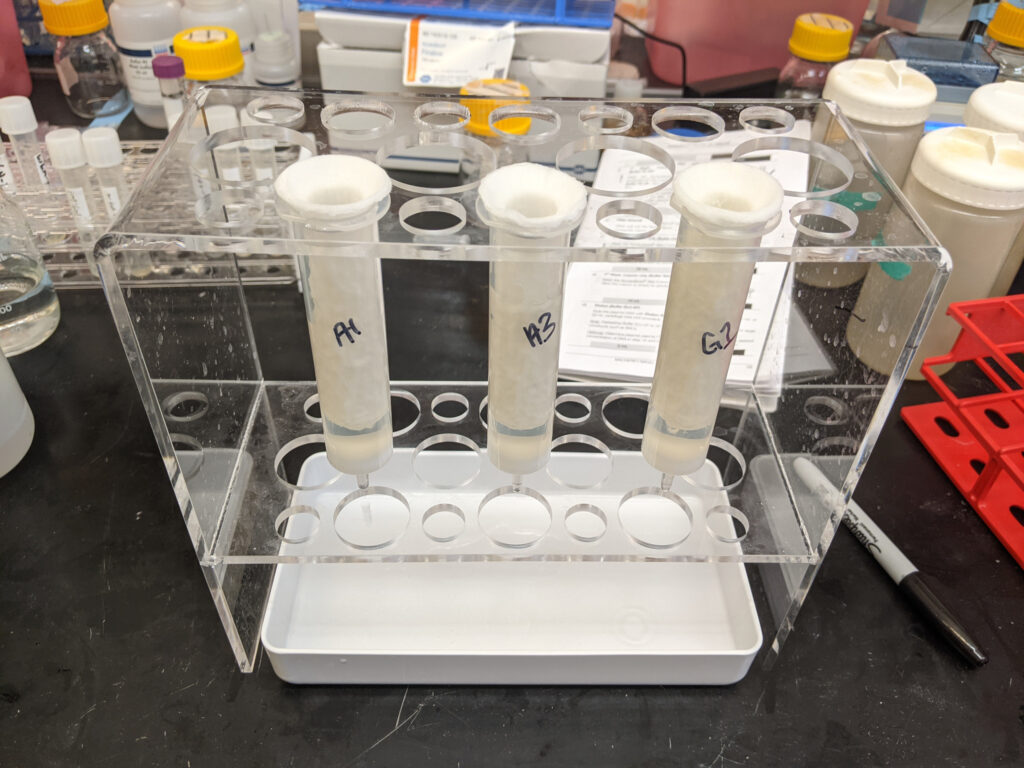
These were the filters used to help extract the DNA from bacteria solution.
Friday
This day was relatively mellow. All I did in the lab was watch as my mentor cleaned glassware. This is done by washing biologically contaminated dishes with a bleach solution, then water. Once these are rinsed, they are brought to an industrial dishwasher in the back where they are pressure-washed to remove any other substances. The last step is to cover their openings with foil or a cap (to prevent airflow), then run them through the autoclave to sterilize.
Once lunch came around, the Ye lab went over to the beach to celebrate Midsummer with one of the Swedish coworkers. There we ate authentic Swedish dishes, made flower crowns, and listened to some music. An interesting opportunity to be able to attend especially in my first week.
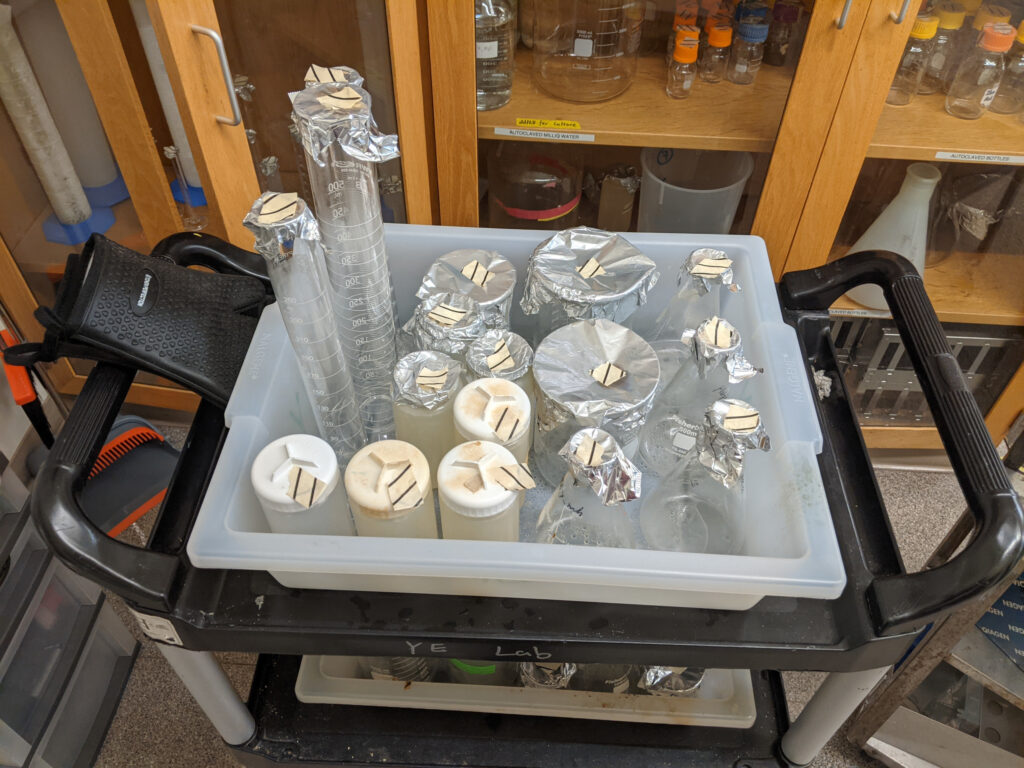
This is what the glassware looks like after it has been cleaned and sterilized.
The above overview covers the major events inside of the workweek. There was a lot of extra time outside of viewing those procedures, which was filled mainly with what some people would consider more mundane work. For me, the free lab-time included mostly taking notes on the aforementioned procedures, reading policies, taking the Scripps online training courses, and reading/learning what I can about the subjects of study. So, while the experiments and techniques might be more exciting and therefore discussed more frequently, it is important to keep in mind that a lot of the time in the lab is spent learning more in between procedures.
Week End
To top off the first work week and the final days of my family vacation, we booked some short surfing lessons at La Jolla Beach for Saturday morning. Once there, we went to the surf shop, put on the wet suits, a new experience for my sister and I, and walked to the shore. The instructor gave us a brief rundown on how to control the surfboard, mount it, and avoid stingrays. From there we got into the water where we enjoyed around an hour of surfing for our first time. Then we packed up, returned the gear, and went back to the Air-Bnb to hang out for the rest of the evening.
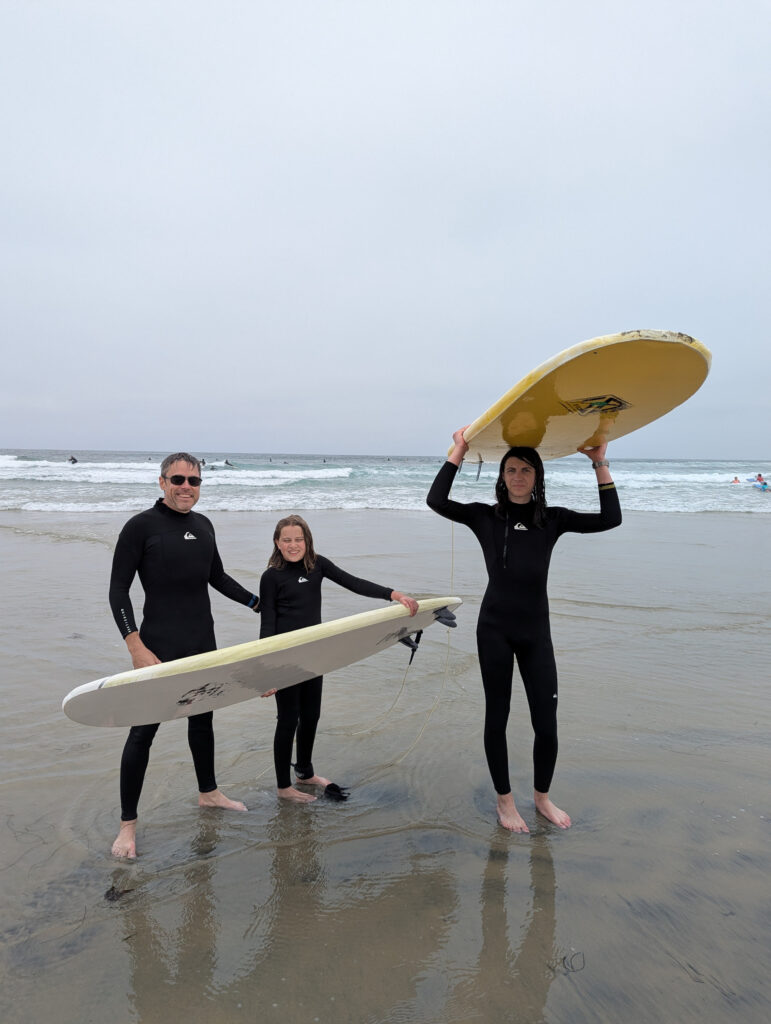
My family and I right after we completed our first surf lessons.
The following day, my sister and dad left to go explore more of San Diego for their last free day here, while I finished writing my blog. Unfortunately, the blog had to be posted on June 24th, a Monday, because the lab P.I. (principle investigator) had not allowed the public release of the pictures used at the time.
Thank you for your patience and for reading my blog,
Ian Snapp

There are no comments published yet.